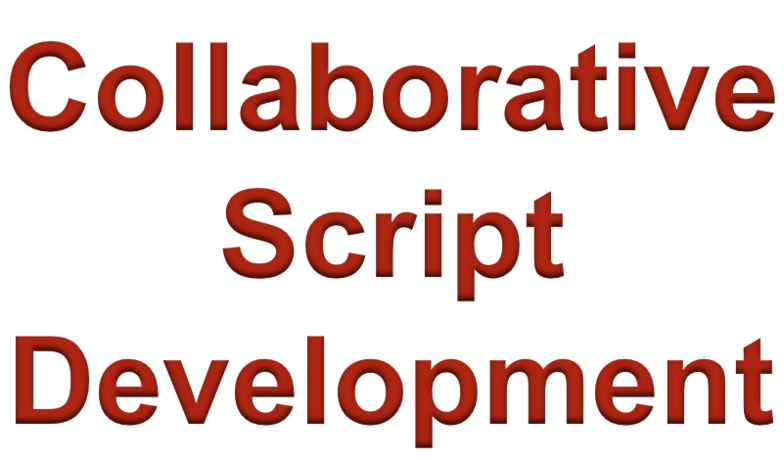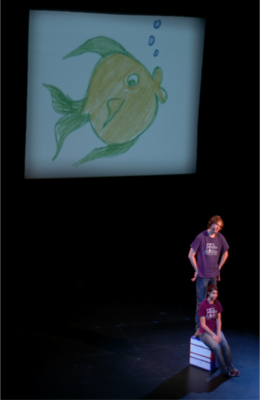Patricia Helsel
Recording the audience as the engage in mouth noises to simulate the dropping of apples.
Assembling the audience to record crowd scenes.
Goals
Our primary goal is to engage the audience and production team in the process of story telling, of “showing” and “being” rather than simply “telling.” With the explosion of desktop media production we want to engage young audiences in imagining themselves as creators.
The Ultimate Audiobook must engage the audience through two different media styles: Live performance and Internet publication (YouTube.) We intended for sound to be a predominant element in story telling. It is imperative that sound:
- motivate plot action
- support (and synch) actors’ movements for theatre audience
- create supportive environments integrated with the story arch
- provide locales (there is no scenery to speak of)
- create effects that help actors’ characterizations and movements (e.g. winds, bear transformations)
- convey movement and physical action to an internet audience
Finally, from an academic perspective, in a program dedicated to technology, it is our desire to push all our capabilities in media rich storytelling.
Description
Process
The Ultimate Audiobook is both an interactive theatre performance and a fully scored audio book. The production toured local elementary schools and integrating the contributions of elementary school students in the form of:
- projected artwork (in public performances)
- creating live sounds and vocal recordings.
- whole audience action/participation (being the sea, responding to character’s questions)
- being a part of the on-stage action (e.g. as sparrows, wind, and court dignitaries)
The actors wore body mics enabling technicians to mix the live sound, balancing it with the pre-recorded cues and music.
In the public performances the “set” consisted of an 18” block and a large projection screen upon which children’s illustrations appeared. The live production was closer in style to a theme park show than a traditional play or theatrical work due to its focus on sound and movement. The production included collaborative script development.
The faculty chose three fairytales, works in the public domain, that we would convert from a short story format to a script format. This allowed us to avoid past difficulty initiating rights contracts. We chose three short productions for touring and wanted to provide opportunities to several Sound Design students. For the public performances two of the three stories were performed at each showing in rotation.
Research – We engaged students in researching the stories and choosing versions.
- symbolism and themes
- fairytale versions
- critical analysis of each story
- music and cultural research related to setting
Brainstorming – Live sessions with a chalkboard, and online communication using Basecamp. Examples of questions we addressed:
- As we moved from story to theatre how do we convey the story with movement, sound and dialog and minimal (or no) narration?
- What are the important symbolic through lines and themes?
Character Creation – Took place in the form of several recorded and transcribed improvisation sessions.
- encouraged experimentation with voices and sounds
- improvisations resulted in fairly dull but effective dialog
- generated and resolved some questions of anachronisms and other elements of style (particularly time period)
Script Refinement – Actors, designers and faculty work on Script development continued through rehearsals for approximately three weeks. 2-3 weeks before opening, the script was solidified with no major changes. Settling on the script provided stability for actors and the repetition required to integrate sound effects with acting in a consistent performance.
Workshop Element/Interactivity – Through the rehearsal process we identified areas in the script in which we could engage the audience. It was decided to record the audience before the performance, reading lines and doing sound effects (mouth noises), and to have some audience on stage for specific moments. Each performance included time to rehearse the audience in their stage roles. This activity provided the engineers time to process the recordings and add them to QLab.
Setting up the sound console for an elementary school performance. Our venues ranged from gymnasiums to libraries.
Anatomy of a Sound Cue
Project Timeline















